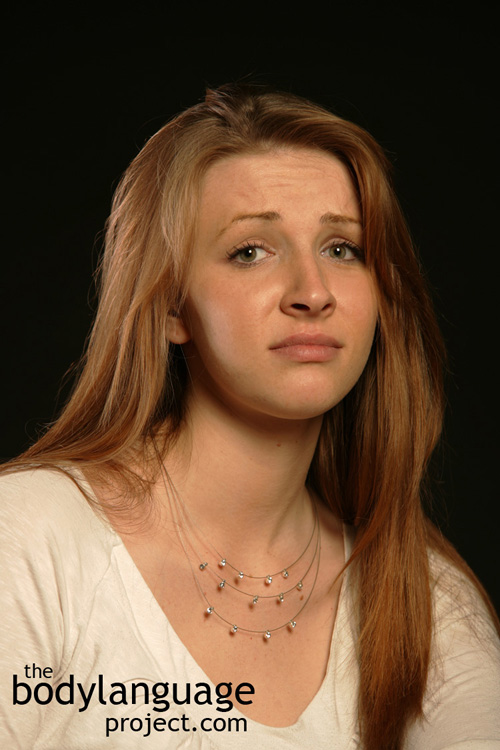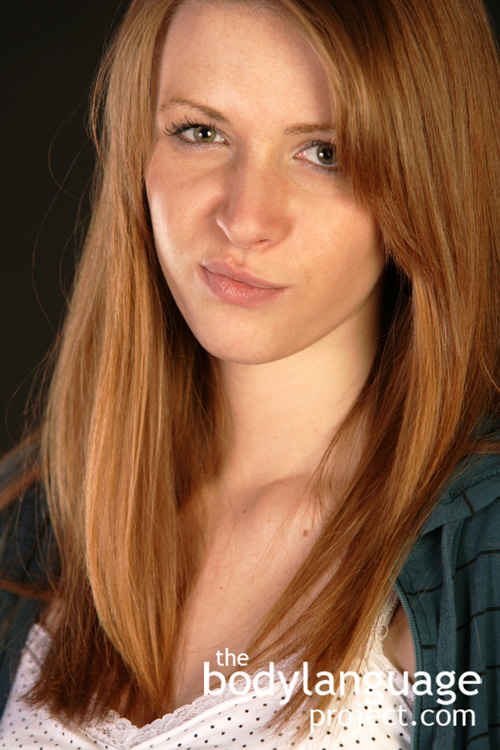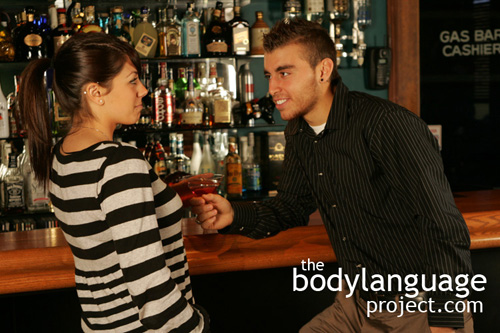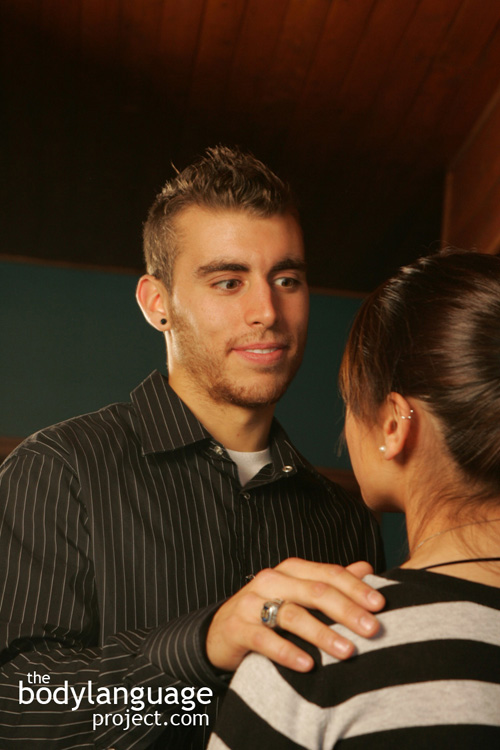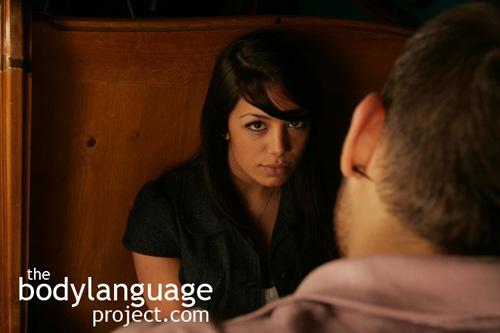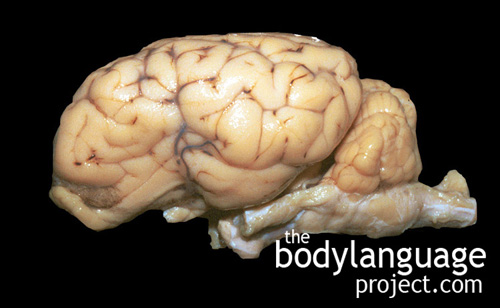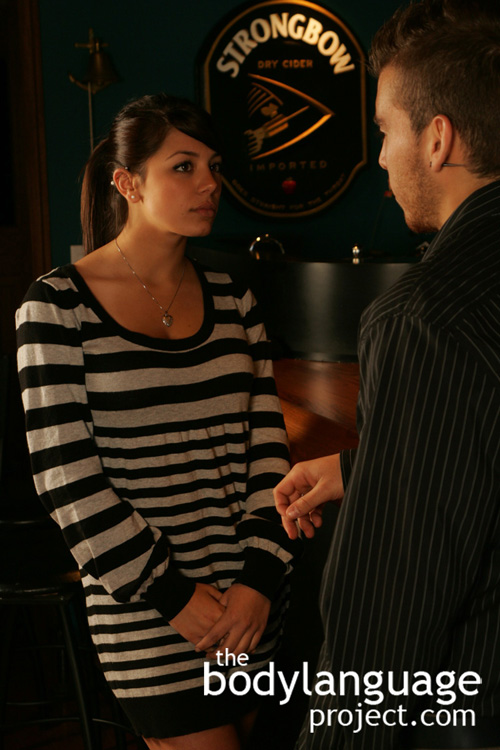
She’s displeased and thinks you should know better.
We’ve seen the hands-on-hips posture before but it resurfaces again in the aggression classification because it is ready posture. In this case, the hands on hips, feet together at attention is accompanied by leaning forward with the head and chin up, or out, and exposed. The hands-on-hips puffs the person out making them seem larger and the feet spread at shoulder width increases stability putting them in a fighting stance. Observations have shown us that ignoring the puffed out chest is to be done at one’s own peril as it is a very strong indicator that a person is about to strike out in aggression. The classic ‘in-your-face’ type of posture indicates readiness for fight and isn’t to be confused with a business ready posture. The accompanying clues which are discussed next, shows an intent to fight, but also tension so there is overlap in fighting nonverbal language and that which stems from other negative emotions such as displeasure, fear, anger, antipathy and disgust. Therefore it is the context, once again, that will tell us the root source of the body language, be it fight or flight.
As aggression nears, our blood “boils” and rushes to the surface of the body making our faces and ears turn red with anger. While blood doesn’t actually boil there is some truth to it. As our nervous system is shifted in the “fight or flight” response our blood pressure increases through a faster heart rate preparing us for action. Since our faces have a high concentration of capillaries and vessels, and the vessels, especially in the cheeks are much wider in diameter than other areas of the body, coupled with the thin skin in the face, permit the redness of the blood to show through in the characteristic “flushing.” This anger reaction shouldn’t be confused with feeling embarrassed or the blushing we see through exercise. The accompanying cues in cluster will tell us which emotional response we are seeing.

Fists clenching is an early sign of aggression. It shows that the body is ready to fight – even if not literally by punching someone.
During aggression we might see the arms show defensive postures by becoming crossed showing a negative emotion, or dropped to the side and clenching. Fists clenching is an important cue to aggression since it indicates the underlying thought process that one is nearing physical action. Other cues in the cluster include finger pointing, overall tensing of the body or extreme body loosening to ready for fighting, tightening of the jaw and lips (called “lip occlusion”), quivering in the lips, frowning, furrowing, or lowering the eyebrows, dilated pupils, squinting of the eyes, crotch displays such as legs open, sneering or flared nostrils.
The technical term for flared nostrils as mentioned before is “nasal wing dilation” and is of particular in the fight and flight response because it tells us that someone is actively oxygenating their bodies in preparation to do something important. Our bodies consume oxygen during work, and we can get our bodies ready by loading up hemoglobin which is the carrier of the oxygen molecule, just in case it’s needed for a condense bout of work. As people get ready to fight their chests can be seen rapidly expanding and contracting as if panting. The body is essentially saying “We’ve probably got a problem on our hands, time to load up on oxygen as we might need to fight or take flight!” Sometimes though, nasal wing dilation is in response to doing anything physical at all, be it to move a heavy sofa or taking to a flight of stairs. Other times, nostrils flare when aroused by a potential mate who is seeking to take up an alluring scent laced with sexual pheromones. However, as mentioned this cue can be very important in certain context as it may provide clues to potentially aggression. School aged children should learn this nonverbal cue early on so as to diffuse aggression by bullies.

Nose flaring or “nasal wing dilation” signals displeasure and negative thoughts. Noses flare because extra oxygen is being consumed to prepare for battle.
It might be counter-intuitive to think that opening the body up and keeping it loose, is a sign of aggression, since it exposing the body to attack, but in this cue cluster, the posture challenges others to attack. The limbs can seem to dangle from the body and the upper torso might begin to sway back and forth, or bob, similar to what a boxer does seeking an angle to attack. Only in this case, it happens much more discretely such that a surprise attack might be possible.
Conversely, the arms and body can become stiff and rigid as they prepare to defend whereas others will visibly start shaking. As a last resort, aggressive individuals may begin expressing the same thoughts over and over again to assert their position in effort to have their opponent back down. Under more extreme cases, people fall back into more primitive displays of aggression such as banging fists against a table, slamming doors, and even throwing objects. Figuratively, the message being advertised is that the table, the door being slammed, or the chair being thrown, will soon be you!
As the person nears aggression they will begin to invade your personal space, sometimes even ‘head-to-head’ and issue verbal challenges and might burst into nervous laughter even though nothing funny has been said. The solution to aggression is to always back away and give the person as much space as possible while showing defensive postures. Nearly all individuals will cease aggressive behaviour given the proper cues and switches, while other times, the only avoidance to physical combat is the flight response. In other words, run!

